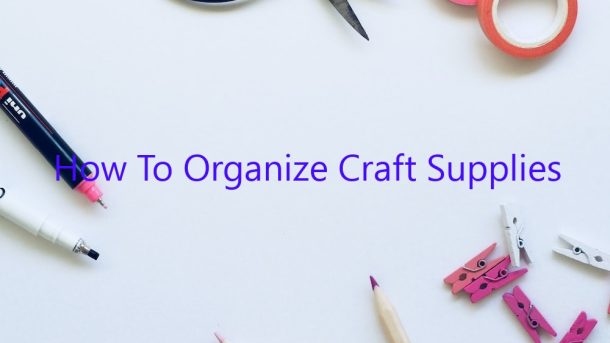Crafting is a fun and relaxing hobby, but it can be difficult to stay organized. If you’re struggling to keep your craft supplies sorted and accessible, here are a few tips to help you get started.
The first step is to create a designated space for your supplies. This can be a corner of a room, a dedicated cabinet or shelf, or even a specific box or bag. Make sure the space is accessible and easy to clean, and that all of your supplies have a designated spot.
If you tend to use the same materials often, consider sorting them into categories. This will make it easy to find what you need, and it will help keep your supplies organized. Some common categories include paper crafting, sewing, beading, and scrapbooking.
Once you’ve created a system, be sure to stick to it! This means putting away your supplies after each use, and only taking out what you need. This will help keep your crafting area neat and organized, and it will save you time in the long run.
With a little bit of organization, you can make your crafting hobby more enjoyable and less stressful. Follow these tips, and you’ll be able to find everything you need in no time.
Contents [hide]
How do you organize craft supplies in a small space?
Craft supplies can be a clutter nightmare, especially if you don’t have a lot of space to work with. Here are a few tips to help you organize your supplies and create an efficient and functional workspace.
1. Start by sorting your supplies into categories. This will help you to see what you have and what you need. You might want to group your supplies by type (e.g. fabric, paper, tools, etc.), by project (e.g. quilts, cards, scrapbooks, etc.), or by color.
2. Choose storage containers that are the right size and shape for your supplies. You don’t want to cram too many supplies into a small container, or have supplies taking up too much space in a large container.
3. Use stackable containers whenever possible. This will help you to save space.
4. Label your containers. This will help you to find what you need quickly and easily.
5. Use storage solutions that can be wall-mounted or stored on a shelf. This will free up counter and floor space.
6. Keep your work area clean and organized. This will help you to stay focused and be more productive.
The key to organizing craft supplies in a small space is to be creative and use every inch of available space. With a little bit of planning and some organizational skills, you can create a functional and beautiful workspace that is perfect for your crafting needs.
How do you declutter craft items?
If you’re like most crafters, you have a stash of supplies that seems to constantly grow. But, eventually, you have to do some decluttering in order to make room for new supplies. Here are some tips on how to declutter your craft supplies:
1. Start by sorting your supplies into categories. This will make it easier to decide what to keep and what to get rid of.
2. If you haven’t used a particular supply in a while, get rid of it.
3. If you have duplicate supplies, get rid of the extras.
4. If a supply is damaged or outdated, get rid of it.
5. Be honest with yourself about how much space you have for supplies. If you don’t have a lot of space, you’ll need to get rid of a lot of supplies.
6. Finally, be willing to let go of your supplies. If you never use them, you might as well get rid of them.
By following these tips, you can declutter your craft supplies and make room for new ones.
How do you declutter and organize a craft room?
A craft room can be a cluttered and chaotic space, but it doesn’t have to be. With a little bit of organization, you can have a craft room that is neat and tidy, making it easy to find what you need and to work on your projects.
The first step in decluttering and organizing your craft room is to get rid of anything you no longer use. This might include supplies you’ve never used, projects you’ve given up on, or tools that are no longer in good condition.
Once you’ve gotten rid of the clutter, it’s time to start organizing. One way to do this is to create zones in your craft room. For example, you might have a zone for crafting supplies, a zone for tools, a zone for storage, and a zone for workspace.
Within each zone, you can then create categories. This will make it easier to find what you need when you’re working on a project. For example, in the crafting supplies zone, you might have categories for fabric, yarn, beads, and so on.
Another way to organize your craft room is to use storage containers. This can be a great way to keep your supplies and tools organized and easy to find. There are a variety of storage containers available, from small containers for holding a few supplies to large containers for holding entire projects.
Finally, don’t forget to label everything. This will make it easier to find what you need, even when the room is cluttered. Labels can be as simple as a written label or as elaborate as a label that is illustrated or even 3D-printed.
With a little bit of effort, you can declutter and organize your craft room, making it a more productive and enjoyable space to work in.
How do I organize craft supplies in my closet?
Craft supplies can be some of the most difficult items to organize in your home. They can take up a lot of space, and it can be hard to know what to do with them all. If you’re struggling to find a way to organize your craft supplies, don’t worry – you’re not alone.
There are a few different ways to organize your craft supplies in your closet. One way is to use bins or boxes to store your materials. This can be a good option if you have a lot of supplies, as it will help you to keep everything organized and easy to find. You can also use shelves to store your supplies. This is a good option if you have a limited amount of space in your closet.
Another thing to consider when organizing your craft supplies is the type of supplies that you have. If you have a lot of fabric, for example, you might want to store it in a bin or box. If you have a lot of art supplies, you might want to store them in a separate drawer or cabinet.
No matter how you choose to organize your craft supplies, the most important thing is to make sure that everything is easy to find. Label your bins and shelves, and make sure that everything is sorted in a way that makes sense to you. This will make it easier to find what you need when you’re working on a project.
Organizing your craft supplies can be a challenge, but it’s definitely worth it in the end. With a little bit of effort, you can create a system that works for you and makes it easy to find everything you need.
How do you display art supplies in a small space?
There are a few different ways to display your art supplies in a small space. You can use a small desk or table to store your supplies, or you can hang your supplies on the wall.
If you want to use a small desk or table to store your supplies, you can either use a desk with drawers to store your supplies, or you can use a desk with a hutch to store your supplies. If you want to use a desk with drawers, you can either store your supplies in the drawers, or you can store your supplies in the desk’s top drawer. If you want to use a desk with a hutch, you can store your supplies in the hutch’s shelves.
If you want to hang your supplies on the wall, you can use a pegboard to store your supplies. You can either use a pegboard with hooks to store your supplies, or you can use a pegboard with shelves to store your supplies. You can also use a corkboard to store your supplies. You can either use a corkboard with hooks to store your supplies, or you can use a corkboard with shelves to store your supplies.
How do you turn a small room into a craft room?
If you’re like many crafters, you may often find yourself wishing you had more room to work. Even a small room can be turned into a craft room with a little bit of ingenuity and some organizing tips.
The first step is to figure out what you need in your craft room and what can be stored elsewhere. Often, craft supplies can be stored in other parts of the house; for example, you may be able to keep fabric in a closet or craft paints and brushes in a kitchen cabinet.
Once you’ve determined what needs to be in your craft room, it’s time to start organizing. One way to make the most of a small space is to use vertical storage. Shelves, racks, and pegboards can all be used to store supplies and tools. Another option is to use drawers and baskets to store supplies. This will keep everything organized and easy to find.
If you’re short on floor space, consider using a table or desk as your work surface. This will free up more room to move around. You can also use a folding table to create more space when you need it.
Finally, make sure to use every bit of space in your craft room. Hang fabric on the walls, store supplies in the closet, and use every shelf and pegboard. By using every inch of your craft room, you’ll be able to work more efficiently and have more space to store your supplies.
How do I stop crafting hoarding supplies?
Crafting hoarding supplies can be a fun and rewarding hobby, but when it starts to take over your life and home, it can become a problem. Here are a few tips on how to stop crafting hoarding supplies and get your life back on track.
The first step is to identify the root of the problem. For some people, crafting becomes a way to avoid dealing with their problems, while for others, the satisfaction of completing a project is addictive. Once you understand why you are hoarding supplies, you can start to address the underlying issue.
If you find that you are using crafting as a way to avoid your problems, try to find healthier ways to cope with your stress. This may involve talking to a therapist or joining a support group.
If you are addicted to the satisfaction of completing projects, try to set realistic goals for yourself. Instead of trying to complete a project in a day, try to make a plan that allows you to complete it over the course of a few weeks. This will help to reduce the temptation to purchase more supplies.
Finally, try to get rid of any excess supplies that you don’t need. Donate them to a local charity or sell them online. This will help to reduce the temptation to purchase more supplies in the future.




